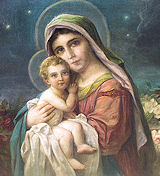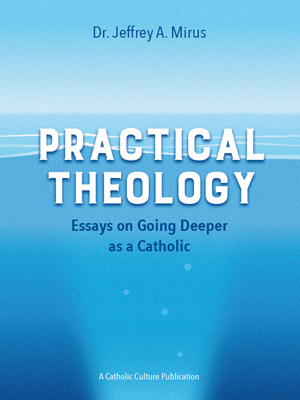Subscribe for free today!
Get newsletters with the latest content, and access to exclusive ebooks and podcast episodes.
Already subscribed? Log in to stop seeing invitations to subscribe.
October 2025 — Overview for the Month
The Holy Father's Intentions for the Month of October 2025
For collaboration between different religious traditions: Let us pray that believers in different religious traditions might work together to defend and promote peace, justice and human fraternity. (See also http://www.popesprayerusa.net/)
Feasts for October 2025
1. Thérèse of the Child Jesus, Memorial
2. Holy Guardian Angels, Memorial
4. Francis of Assisi, Memorial
5. TWENTY-SEVENTH SUNDAY IN ORDINARY TIME, Sunday
6. Bruno; Bl. Marie Rose Durocher (USA and CAN), Opt. Mem.
7. Our Lady of the Rosary, Memorial
11. St. John XXIII, Opt. Mem.
12. TWENTY-EIGHTH SUNDAY IN ORDINARY TIME, Sunday
14. Callistus I, Opt. Mem.
15. Teresa of Jesus, Memorial
16. Hedwig; Margaret Mary Alacoque, Opt. Mem.
17. Ignatius of Antioch, Memorial
18. Luke, Evangelist, Feast
19. TWENTY-NINTH SUNDAY IN ORDINARY TIME, Sunday
20. Paul of the Cross, Opt. Mem.
22. John Paul II, Opt. Mem.
23. John of Capistrano, Opt. Mem.
24. Anthony Mary Claret, Opt. Mem.
26. THIRTIETH SUNDAY IN ORDINARY TIME, Sunday
28. Simon & Jude, Apostles, Feast
Focus of the Liturgy
The Gospels for the Sundays in October 2025 are taken from St. Luke for Cycle C; Weekdays follow Year I.
| October 5th | Luke 17:5-10: If you have faith! |
October 12th | Luke 17:11-19: None but this foreigner has returned to give thanks to God. |
October 19th | Luke 18:1-8: God will secure the rights of his chosen ones who call out to him. |
October 26th | Luke 18:9-14: The tax collector, not the Pharisee, went home justified. |
Highlights of the Month 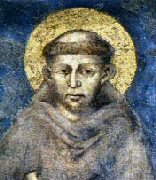 October, as in all of Tempus per Annum, or Ordinary Time (formerly known as Time After Pentecost), the Liturgy does not focus on one particular mystery of Christ, but views the mystery of Christ in all its aspects. We follow the life of Christ through the Gospels, and focus on the teachings and parables of Jesus and what it means for each of us to be a follower of Christ.
October, as in all of Tempus per Annum, or Ordinary Time (formerly known as Time After Pentecost), the Liturgy does not focus on one particular mystery of Christ, but views the mystery of Christ in all its aspects. We follow the life of Christ through the Gospels, and focus on the teachings and parables of Jesus and what it means for each of us to be a follower of Christ.
This month the main liturgical feasts are:
St. Thérèse (October 1),
Guardian Angels (October 2),
St. Francis of Assisi (October 4),
St. Bruno (October 6),
Our Lady of the Rosary (October 7),
St. Denis, St. John Leonardi and St. John Henry Newman (October 9),
St. John XXIII (October 11),
St. Callistus I (October 14),
St. Teresa of Jesus (October 15),
Sts. Hedwig and Margaret Mary Alocoque (October 16),
St. Ignatius of Antioch (October 17),
St. Luke (October 18),
St. Paul of the Cross (October 20),
St. John Paul II (October 22),
St. John Capistrano (October 23),
St. Anthony Mary Claret (October 24), and
Sts. Simon and Jude (October 28).
The commemorations of St. Faustina and Bl. Francis Xavier Seelos (USA) (October 5), St. Carlo Acutis (October 12), and Sts. John de Brébeuf, Isaac Jogues, and Companions (October 19), fall on a Sunday so they are superseded by the Sunday Liturgy.
Autumn Festivities 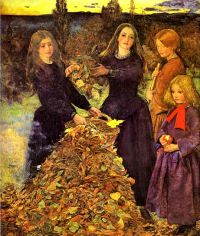 October usually is an enjoyable time of the year in the United States. The autumn season manifests itself with wonderful fall foliage in many parts of the country. The temperatures are cooler, inviting people outdoors for nature walks, apple or pumpkin picking. School routines are more established and football season is in full swing. The celebrations of the Church for the month of October are also wonderful and unique. The feasts of some of the most popular saints of the universal Church are celebrated during this month: St. Thérèse the Little Flower (France), St. Francis of Assisi (Italy) and St. Teresa of Avila (Spain). These saints come from different countries, and in honoring these saints we can include cultural dishes or activities from each country to make the feastday even more special. Read more about the lives of these saints. Perhaps the family can pick one virtue that each saint practiced well and try to implement it.
October usually is an enjoyable time of the year in the United States. The autumn season manifests itself with wonderful fall foliage in many parts of the country. The temperatures are cooler, inviting people outdoors for nature walks, apple or pumpkin picking. School routines are more established and football season is in full swing. The celebrations of the Church for the month of October are also wonderful and unique. The feasts of some of the most popular saints of the universal Church are celebrated during this month: St. Thérèse the Little Flower (France), St. Francis of Assisi (Italy) and St. Teresa of Avila (Spain). These saints come from different countries, and in honoring these saints we can include cultural dishes or activities from each country to make the feastday even more special. Read more about the lives of these saints. Perhaps the family can pick one virtue that each saint practiced well and try to implement it.
The feasts in October also include two of the most popular, time-honored devotions of Catholics, the devotion to the Holy Rosary (October 7) and the Guardian Angels (October 2). In October 2002 St. John Paul II wrote the Apostolic Letter Rosarium Virginis Mariae (the Rosary of the Virgin Mary)."
This letter introduced five new mysteries, called the Luminous or Mysteries of Light, which are:
- Jesus' Baptism in the Jordan
- Jesus' self manifestation at the wedding of Cana
- Proclamation of the Kingdom of God, with the call to conversion
- the Transfiguration, and
- the Institution of the Eucharist.
Try to make a more concerted effort to pray the Rosary together as a family during the month of October, read the Apostolic Letter to understand the beauty of this devotion more deeply, and pray the Luminous mysteries.
Every person has a guardian angel assigned to them, and October 2 the Church celebrates the role of these Guardian Angels. We should show devout gratitude to God for placing these angels at our service. Having a guardian should give us confidence during all of life's difficulties. Every Catholic should know the Angele Dei (Angel of God) prayer and pray it often. The Directory on Popular Piety suggests that families pray it at morning and evening prayers or after the Angelus.

All Hallows' Eve or Halloween heralds the month of November with emphasis on the Communion of Saints, especially the Church Suffering (the Poor Souls in Purgatory) and the second coming of Christ or Parousia. This last day of October on the secular calendar is second only to Christmas in commercial preparations. The Christian focus is on the Communion of Saints and the Last Things. As Christians living a "Catholic Culture", we can try to explore the Christian roots of the Halloween festivities.
This item 12529 digitally provided courtesy of CatholicCulture.org


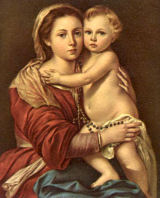
 October 18
October 18


 The sailing vessel here represents the Church, which St. Jude (also known as Thaddeus or Lebbaeus) carried to many ports as he journeyed as a missionary.
The sailing vessel here represents the Church, which St. Jude (also known as Thaddeus or Lebbaeus) carried to many ports as he journeyed as a missionary.  The companion of St. Jude on many missionary journeys, St. Simon was known as a great fisher of men through the power of the Gospel.
The companion of St. Jude on many missionary journeys, St. Simon was known as a great fisher of men through the power of the Gospel.  St. Francis, the father of the Franciscan Order, for two years before his death bore the marks of the Lord's Passion upon his hands, feet and side. The tears on the cross represent the marks of the stigmata.
St. Francis, the father of the Franciscan Order, for two years before his death bore the marks of the Lord's Passion upon his hands, feet and side. The tears on the cross represent the marks of the stigmata.  A convert of St. John, reputedly consecrated Bishop of Antioch by St. Peter, St. Ignatius was an important link between the first and second centuries of the Church. He was the writer of seven epistles as he proceeded to his martyrdom when condemned by Trajan.
A convert of St. John, reputedly consecrated Bishop of Antioch by St. Peter, St. Ignatius was an important link between the first and second centuries of the Church. He was the writer of seven epistles as he proceeded to his martyrdom when condemned by Trajan.